
|
Sale 81
The Pre-Long Beach Sale
| Lot |
Photo |
Description |
Realized |
Lot 1243 |
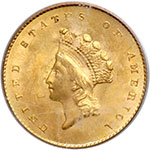 |
1854. PCGS graded MS-63. Housed in an Old Green Holder. Frosty and lightly toned. Both sides are soaked in vibrant-gold iridescence that accents the ample remaining luster with surfaces swirling fresh, the color gorgeous. Clear-cut devices point to it having been giving a full strike by the dies. A marked improvement over most Type 2 Dollars where uneven strikes abound. Should prove a favorable choice for a collector�s Gold Type Set (PCGS # 7531) .
Note: The relief of the obverse motif on the Type 2 design was too high and engraver James Longacre had situated it conflicting with the highest points of the reverse. This led to poor metal flow into the die cavities, and even the capable Philadelphia Mint could rarely generate fully struck examples. Most pieces emerged from the branch mints far worse, with weak devices, and rapidly wore down to illegibility. The barely identifiable survivors that the Mint retrieved from circulation were melted as hastily as they had been designed. After two years of production at Philadelphia and token outputs at the other facilities that extended into 1856, Longacre reworked the denomination and created the Type 3 gold dollar, 1856-89.
Estimated Value $6,000 - 6,500.
View details and enlarged photos
Check results on similar lots
| Realized
$7,050 |
Lot 1244 |
 |
1854. NGC graded MS-61. A lustrous untoned Type 2 Gold Dollar, typically well struck for this date (PCGS # 7531) .
Estimated Value $1,500 - 1,600.
View details and enlarged photos
Check results on similar lots
| Unsold |
Lot 1245 |
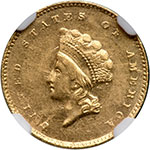 |
1855-C. NGC graded MS-62. Very Frosty and untoned. Only 9,803 struck. Reportedly because it was smaller and thicker than convenient, Mint Director Colonel James Ross Snowden instructed the coin department for the Gold Dollar to be redesigned in 1854, in order to accommodate an increase in diameter to 15 millimeters. Chief Engraver Longacre dutifully carried out this request, though his work was uncharacteristically slipshod and rushed-looking on this occasion. Longacre's Type 2 design was difficult to strike due to thinness, it wore down rapidly in circulation, and proved unsuccessful. These deficiencies affected all issues of this type, and they resulted in its replacement by the Type 3 design in 1856 (1857 for the San Francisco Mint).
Due to its brevity, there are only six coins in the Type 2 Gold Dollar series: 1854, 1855, 1855-C, 1855-D, 1855-O, and 1856-S. The '55-D is by far the rarest, followed by this desirable '55-C, '56-S and '55-O. Even the "common" 1854 and 1855 are relatively scarce coins in an absolute sense that are difficult to acquire in Mint State from a market availability standpoint. The 1855-C however, is legendary as a condition rarity in Mint condition. Pop 4; none finer at NGC. (PCGS # 7533) .
Troubles at the Mint: Upon receiving his post to Mint Director in 1853, Colonel James R. Snowden readied plans to modify the Gold Dollar that James B. Longacre had executed in 1849. To this end, Longacre increased the diameter of the denomination, as mentioned above, from 13 to 15 millimeters while he reduced the thickness proportionately. At the same time, he seized upon the opportunity to redesign both the obverse and reverse devices. The chief engraver altered the Gold Dollar's resemblance to the double eagle when he utilized his replica of the marble Venus Accroupie from the Three-dollar gold piece. The wreath is made up of corn, cotton, maple, and tobacco and is one that Longacre would in due course reacquaint the public with on the Flying Eagle cent and the new Type 2 Gold Dollar. Once the Treasury Department agreed to the changes, coinage began on August 19, 1854. Soon thereafter, the Mint discovered the new design's shortcoming: The relief of the obverse motif was too high. Longacre had situated it opposite the highest points of the reverse. This created poor metal flow into the die cavities, and even the capable Philadelphia Mint could not generate fully struck examples consistently. Most pieces emerged from all four Mints with weak devices, and rapidly wore down to illegibility. The barely identifiable survivors that the Mint retrieved from circulation were melted as hastily as they had been designed. After two years of production at Philadelphia and mere token outputs at the branch mints that extended into 1856, Longacre reworked the denomination and replaced it with the Type 3 Gold Dollar.
Estimated Value $26,000 - 28,000.
View details and enlarged photos
Check results on similar lots
| Unsold |
Lot 1246 |
 |
1855-C. NGC graded MS-61. Nicely toned. Only 9,803 struck. A much better struck example than is typical for this issue with clarity at the central hair in spite of a few clashmarks around the portrait. The feather tops are, however flattened or gently bowed, providing evidence the thin planchet, though of the exact weight specified in the legislation, was insufficient to allow metal flow into the deepest die recesses. Soft luster with attractive reddish to pale orange-gold and rose tone; the surfaces are choice with the exception of a hairline or two near DOLLAR and the date on the reverse. Noteworthy is the fact the reverse is as detailed as we can recall having seen on an 1855-C gold dollar.
Critics are sometimes inclined to reproach, deride, blame and generally hammer the quality of branch mint Type 2 Gold Dollars because of their uneven strikes and consecutive and often broken appearance due to die clash marks, as if this were a plot of some sort. They do not realize the difficult conditions under which the press operators were working, forced as they were to use the flawed small Indian Head dies and thin planchets authorized by the Mint Director and staff. The mint presses in those days simply were not capable of dealing with this combination. All the same, the 1855-C is the rarest collectible Gold Dollar from Charlotte Mint in upper grades. And well regarded because of this. A lovely MS61, the coin offered here is certainly high in the Condition Census, and is among the finest examples that have been offered in many years. It is a highlight of what is clearly a nice selection of Charlotte and Dahlonega gold in the current sale. Pop 8; 5 finer, 1 in 61+, 4 in 62. (PCGS # 7533) .
Estimated Value $23,000 - 24,000.
View details and enlarged photos
Check results on similar lots
| Unsold |
Lot 1247 |
 |
1855-C. NGC graded AU-58. Nice golden toning. Only 9,803 struck. The strike is crisp in a few areas, though some lack of detail may be noted at the central portrait where Liberty's hair is ill-defined; the reverse is weaker, which is typical for 1855-C. Noteworthy are softly impressed leaves n the wreath on both sides, LL and 8 are also affected since they lie opposite the highest obverse design which precluded the metal from filling the die recesses. Sharp C mintmark, as always. Much better detail in the rim denticles. Surfaces retain some muted luster in the areas around the devices. No obvious marks other than a few normal circulation abrasions.
The Charlotte, North Carolina mint struck Gold Dollars each year from 1849 to 1861. In the latter year, the Southern states seceded from the Union and formed their own Confederacy, at which time the Mint ceased operations. By the later 1850s and first two years of the 1860s, yearly Gold Dollar production at this facility was a mere trickle. Pop 34; 17 finer, 4 in 60, 8 in 61, 1 in 61+, 4 in 62. (PCGS # 7533) .
Estimated Value $15,000 - 16,000.
View details and enlarged photos
Check results on similar lots
| Unsold |
Lot 1248 |
 |
1855-C. PCGS graded AU-53. Frosty, untoned and struck on a faulty planchet as usual. The only Charlotte, North Carolina Mint issue for the truncated Type 2 design, which the various Mints produced in 1854-56 before modifications were required. Attractive smooth reddish-gold luster illuminates the legends and outlines the motifs of this accurately graded About Uncirculated specimen. Minimal abrasions are noted, none of major consequence, we note a few flakes or shallow depressions on the obverse below D of UNITED, and random circulation abrasions; noteworthy, but quite common with these, is die clashing on both sides, mainly visible around Liberty and, correspondingly, within the confines of the cereal wreath on the reverse. The very low mintage ensures the rarity. Only 9,803 struck. Pop 15; 21 finer at PCGS. (PCGS # 7533) .
Estimated Value $7,000 - 7,500.
View details and enlarged photos
Check results on similar lots
| Unsold |
Lot 1249 |
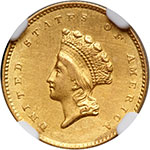 |
1855-O NGC graded AU Details Improperly Cleaned. Only 55,000 minted (PCGS # 7535) .
Estimated Value $300 - 350.
View details and enlarged photos
Check results on similar lots
| Unsold |
Lot 1250 |
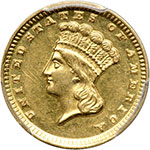 |
1859-D. PCGS graded MS-62. Only 4,952 struck. For the collector interested in Dahlonega Mint gold this 1859-D is a lustrous representative, struck late in the Mint�s brief existence (1838-61). It is one of only a handful in Mint State condition. The strike has much greater detail on the ostrich plume tips and the center parts of the hair on the obverse than is usually seen. At the wreath bow and center of the date on the reverse, weakness occurs, this being true of all authentic specimens. The remaining cereal grains comprising the wreath are well formed to sharp.
It seems likely that no one was collecting branch mint gold in this period. Numismatically, none were saved at the time. Survivors exist for other reasons. It is for this reason survival of high-grade pieces is a matter of chance. For the 1859-D, "high grade" nicely describes anything from About Uncirculated 58 to Mint State 61 to 62.
We have been honored to have handled a number of specialized collections of Dahlonega coins over the years, always a pleasure. These pieces are rustic, and their die characteristics provide never-ending fascination. Occasionally we are all truly delighted with one, as with the present piece. Pop 15; 3 finer, 2 in 63, 1 in 64. (PCGS # 7553) .
Estimated Value $10,000 - 11,000.
View details and enlarged photos
Check results on similar lots
| Unsold |
Lot 1251 |
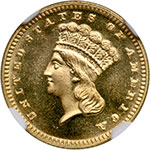 |
1887. NGC graded MS-68. Star CAC Approved. A magnificent super gem specimen! Only 7,500 struck. One of the finest survivors from this year and a coin which must be studied to be appreciated. Note the vibrant golden hue throughout, with the fully struck devices on Liberty and the wreath .The fields are reflective and Prooflike, an event which is quite unusual for a business strike gold dollar. Most likely, this coin was one of the early strikes from a new pair of dies. Of paramount concern is the quality of the surfaces. Rarely are coins of this series found so pristine, and precious few sport grades in the MS68 ionosphere. This particular coin is the only 1887 MS68 Star gold dollar to earn this grade from NGC. An outstanding example of this series. Pop 1; none finer at NGC. Tied for the finest graded by both NGC and PCGS (PCGS # 7588) .
Estimated Value $18,000 - 19,000.
View details and enlarged photos
Check results on similar lots
| Unsold |
Lot 1252 |
 |
1887. PCGS graded MS-63. Lovely rich shades of golden toning. Only 7,500 minted. Housed in an Old Green Holder (PCGS # 7588) .
Estimated Value $525 - 550.
View details and enlarged photos
Check results on similar lots
| Realized
$617 |
Lot 1253 |
 |
1889. PCGS graded UNC Details, Cleaning. Nice prooflike surfaces (PCGS # 7590) .
Estimated Value $350 - 400.
View details and enlarged photos
Check results on similar lots
| Realized
$588 |
|
|